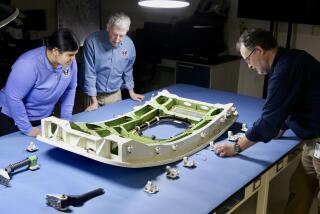Iowa Air Crash Laid to Metallurgical Flaw : Investigation: Tests performed on tail engine part confirm the root cause of the accident.
- Share via
WASHINGTON — A tiny metallurgical flaw that developed 19 years ago in a Nevada plant led to the explosion of a tail engine and the crash of United Airlines Flight 232 in Sioux City, Iowa, last July, a federal official said Saturday night.
Investigators were able to determine the root cause of the accident, which killed 112 of 296 people on board the DC-10, after performing tests on an engine part found earlier this month in an Iowa cornfield.
Anthony J. Broderick, acting executive director of the Federal Aviation Administration, said the flaw was detected in a 300-pound titanium disk that spins the blades in the engine’s forward fan assembly.
Broderick, confirming a report by the Washington Post, said the imperfection developed when the titanium was manufactured in 1970 at the Henderson, Nev., plant of Timet, a division of the Titanium Metals Corp. of America.
The FAA, which had suspected a metallurgical flaw even before tests confirmed it this week, recently ordered an examination of 232 other titanium disks that may have developed similar problems.
The tests on those disks will not be completed until February. Broderick said that irregularities already have been found in two of the disks and that further tests are scheduled.
A federal hearing in Sioux City on Tuesday will seek to determine whether the problem could have been detected before the crash and whether a recurrence of the unprecedented explosion of the United engine can be prevented.
The engine’s disk ruptured after the metallurgical flaw led to the development of fatigue cracks, Broderick said.
The titanium for the disk was manufactured in a process called “double melting.” This involves reducing the metal to a liquid to remove impurities. About 15 years ago, the industry switched to “triple melting,” decreasing the likelihood of metal flaws tenfold, to fewer than 1 per million pounds of titanium produced, Broderick said.
A microscopic change in the metal’s crystalline structure produces a knotty imperfection known as a “hard alpha.” The flaw cannot be detected in tests but a new ultrasonic probe can pick up cracks that grow from the flaw, Broderick said. With the disk submerged in water and high frequency sound waves, computers can analyze any irregularities in the echoes.
“At some point after the melting, cracking develops,” Broderick said in describing what happened to the United disk. “And those cracks can be the source of fatigue cracks. The growth of the fatigue cracks caused the problem. We are quite confident that the testing we are doing now will weed out any possible defective disks.”
The metal produced by Timet was forged by the Aluminum Co. of America. GE Engines, a division of General Electric Co., finished the part in 1972 and assembled the engines.
Spokesmen for the companies could not be reached for comment.
After its engine exploded in flight, cutting the plane’s hydraulic lines, the United aircraft spiraled toward Sioux City, almost totally out of control. Debris from the exploding engine pierced the tail and severed hydraulic cables that control altitude and direction. By increasing the thrust of one of the wing-mounted engines and reducing it in the other, Capt. Alfred C. Haynes was able to turn the plane slightly.
The jumbo jet cartwheeled on the runway, broke apart and burst into flames.
More to Read
Sign up for Essential California
The most important California stories and recommendations in your inbox every morning.
You may occasionally receive promotional content from the Los Angeles Times.













